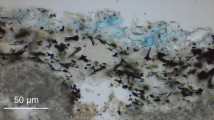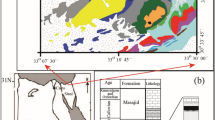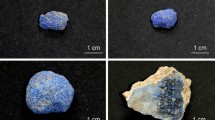Abstract
Metalloporphyrins are minor constituents in crude oil and its relatives1 but their presence in coal is not clearly established. This is surprising as such complexes are thought to arise from chlorophyll, and coal is largely of plant origin. Although coal samples were among the earliest examined in this context2,3, most later workers1,4 followed Treibs5 in mainly considering crude oils, asphaltenes and shales. Weigelt and Noack2 presented early evidence for chlorophyll derivatives in fossilised leaves from brown coal, while Treibs3 found trace amounts of metal-free porphyrins in various coals. Uspenskii and Gorskaja6 confirmed the latter finding, but observed that the porphyrin content of sapropelic coals such as cannel coal was much higher than that of hard coals. Metalloporphyrins in fossil plant material are important because they provide information on the geochemical transformations of chlorophyll. Moreover, metal complexes with organic ligands (such as the metalloporphyrins) are of particular interest in contemporary coal chemistry because they are probably extracted by the organic solvent in the conditions used in certain coal liquefaction processes, and hence may modify the activity of catalysts used in subsequent chemical reactions with the coal extract. We report here the isolation of a metalloporphyrin fraction from a British bituminous coal, and show that the principal metal present in the isolated material is gallium.
This is a preview of subscription content, access via your institution
Access options
Subscribe to this journal
Receive 51 print issues and online access
$199.00 per year
only $3.90 per issue
Buy this article
- Purchase on Springer Link
- Instant access to full article PDF
Prices may be subject to local taxes which are calculated during checkout
Similar content being viewed by others
References
Baker, E. W. & Palmer, S. E. in The Porphyrins Vol. 1A (ed. Dolphin D.), 485–551 (Academic, New York, 1978).
Weigelt, J. & Noack, K. Nova Acta Kaiserlich Leopoldinisch–Carolinischen Deutsch. Akad. Naturforsch. 1, 87–96 (1932).
Treibs, A. Justus Liebig's Ann. Chem. 520, 144–150 (1935).
Hodgson, G. W., Baker, B. L. & Peake, E. Proc. 7th World Petroleum Congr. 2, 117–128 (1967).
Treibs, A. Justus Liebig's Ann. Chem. 509, 103–114; 510, 42–62 (1934).
Uspenskii, W. A. & Gorskaja, A. J. Priroda 27, 15–20 (1938).
Bonnett, R., Charalambides, A. A., Jones, K., Magnus, I. A. & Ridge, R. J. Biochem. J. 173, 693–696 (1978).
Weast, R. C. (ed.) Handbook of Chemistry and Physics 58th edn (CRC, Cleveland, 1977).
Goldschmidt, V. M. J. chem. Soc., 655–673 (1937).
Ratynskii, V. M. & Zharov, Y. N. Chem. Abstr. 91, 126449a (1979).
Ryczek, M. Polish patent 60127 (1970); Chem. Abstr. 74, 89967u (1971).
Didyk, B. M., Alturki, Y. I. A., Pillinger, C. T. & Eglinton, G. Nature 256, 563–565 (1975).
Hutchinson, G. E. Q. Rev. Biol. 18, 242–262 (1943).
Author information
Authors and Affiliations
Rights and permissions
About this article
Cite this article
Bennett, R., Czechowski, F. Gallium porphyrins in bituminous coal. Nature 283, 465–467 (1980). https://doi.org/10.1038/283465a0
Received:
Accepted:
Issue Date:
DOI: https://doi.org/10.1038/283465a0
This article is cited by
-
Distribution, occurrence and enrichment causes of gallium in coals from the Jungar Coalfield, Inner Mongolia
Science China Earth Sciences (2011)
-
Structure and transformation of the major coal porphyrins
The Science of Nature (1990)
Comments
By submitting a comment you agree to abide by our Terms and Community Guidelines. If you find something abusive or that does not comply with our terms or guidelines please flag it as inappropriate.



